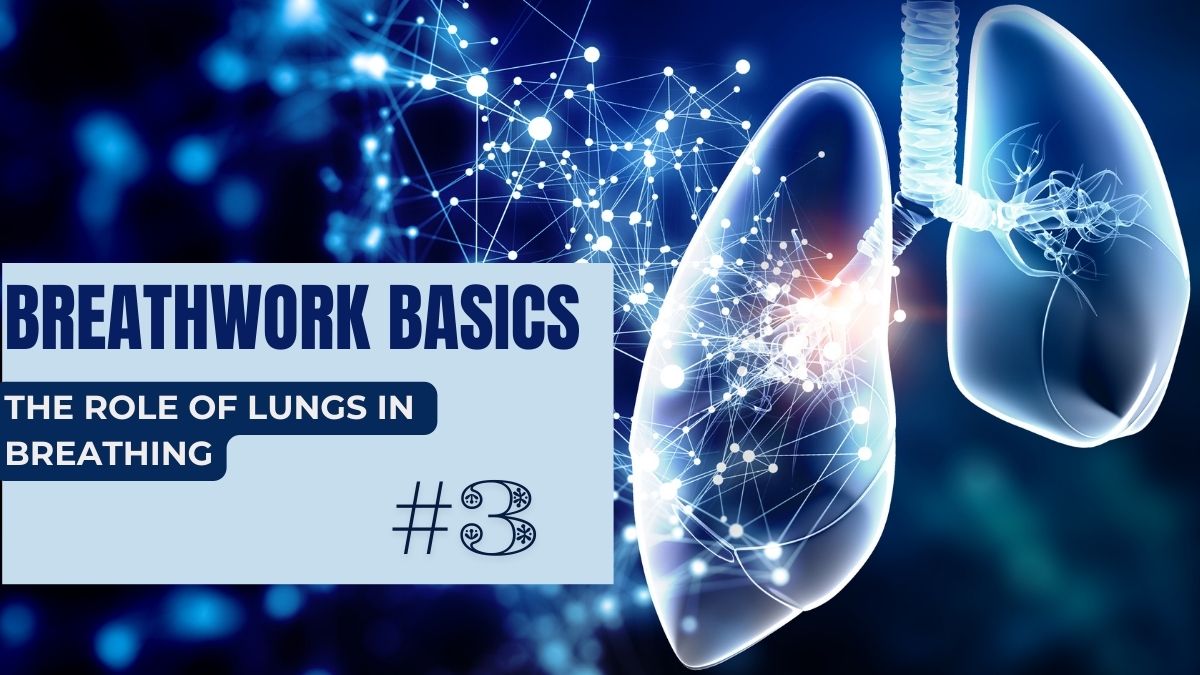Breathwork Basics 3: The Role of Lungs in Breathing

Explore breathwork basics and the role of lungs in breathing. Learn about lung function, anatomy, and fun facts to improve your respiratory health.
Hey there, fellow breathers! Today, we’re diving deep into the magic that happens inside our chests every single moment of our lives. That’s right, we’re talking about the lungs and their crucial role in the beautiful dance of breathing. Whether you’re a seasoned breathwork facilitator or just curious about what’s happening when you take a deep breath, this is for you.
Structure and Function of the Lungs
Anatomy of the Lungs
First things first, let’s get to know our lungs a bit better. Nestled snugly in our chest cavity and protected by the rib cage, these marvellous organs are not exactly symmetrical. The right lung is a bit larger with three lobes, while the left lung has two lobes, making room for our heart. This anatomical difference helps accommodate the heart, which sits slightly to the left of the midline in the chest. Fun fact: the left lung's smaller size allows it to fit snugly around the heart, creating a space known as the cardiac notch.

Airways
Breathing starts when air enters through our nose or mouth, travels down the throat, and passes through the trachea. The trachea splits into two bronchi, each leading to a lung. These bronchi branch into smaller and smaller bronchioles, ending in tiny air sacs called alveoli. It’s in these alveoli that the magic of gas exchange happens. Here’s a cool tidbit: if you were to flatten out all the alveoli in your lungs, they would cover an area as large as a tennis court!
Gas Exchange
Now, let’s talk about the main job of our lungs – gas exchange. This process allows oxygen from the air we inhale to enter our bloodstream and carbon dioxide from our blood to be expelled. In the alveoli, oxygen diffuses through the walls into surrounding capillaries, hopping onto haemoglobin in red blood cells. Meanwhile, carbon dioxide makes the reverse journey, leaving the blood to be exhaled. It’s like a well-choreographed dance, ensuring we get the oxygen we need and get rid of what we don’t. Did you know that an average person breathes in about 11,000 litres of air each day?
669e84ddabe1d_lg.jpg)
Mechanics of Breathing
Inhalation
Breathing in, or inhalation, is where the diaphragm (that dome-shaped muscle under the lungs) takes centre stage. It contracts and moves downward, expanding the chest cavity. The intercostal muscles between our ribs join in, lifting the rib cage and creating negative pressure that draws air into our lungs. It’s like a vacuum effect – air just has to come in!
Exhalation
Breathing out, or exhalation, is the relaxing part. The diaphragm and intercostal muscles relax, the chest cavity shrinks, and air gets pushed out of the lungs, taking carbon dioxide with it. It’s the body’s way of saying, “Ahh, that feels better!” Fun fact: when you exhale, you release not just air but also water vapour – up to 17.5 millilitres of water per hour!
Additional Functions of the Lungs
Filtration and Protection
Our lungs are also excellent bodyguards. They produce mucus to trap dust, germs, and other nasties, while tiny hair-like structures called cilia move this mucus out of the lungs. It’s a continuous cleanup operation to keep us breathing easy. This mucus lining is a protective barrier, ensuring that harmful particles are trapped before they can enter the lungs.
Regulation of Blood pH
The lungs play a key role in keeping our blood’s pH level just right. By adjusting our breathing rate and depth, they control the amount of carbon dioxide in our blood, helping to maintain the perfect balance.
Supporting Other Functions
From maintaining the right temperature and humidity of the air we breathe to supporting our sense of smell, the lungs are multitasking marvels. Plus, regular physical activity can increase lung capacity, allowing for more efficient oxygen transport throughout the body. Another fascinating fact: children and women typically breathe faster than men, which is an interesting physiological difference.
How the Lungs and Diaphragm Work Together During Breathing
The diaphragm isn’t just a muscle – it’s a breathing superstar. Let’s see how it teams up with the lungs to keep us alive and well.
Role of the Diaphragm in Breathing
- Inhalation: The diaphragm contracts and moves downward, creating space for the lungs to expand. It’s like rolling out the red carpet for incoming air.
- Exhalation: The diaphragm relaxes and moves back up, reducing space in the chest cavity and pushing air out of the lungs. It’s all about that smooth exit.
668526af6ce5c_lg.jpg)
Interaction Between Lungs and Diaphragm
- Efficient Breathing: When the diaphragm contracts, it gives the lungs room to fill with air. Diaphragmatic breathing exercises, or belly breathing, can strengthen this muscle and improve lung capacity.
- Gas Exchange: This beautiful expansion and contraction dance allows oxygen to enter the alveoli and carbon dioxide to be expelled, ensuring our blood stays oxygen-rich and healthy.
Respiratory Conditions
Sometimes, things don’t go as smoothly. Conditions like COPD can trap air in the lungs, pushing down on the diaphragm and making it less effective. This can force us to rely on other muscles, making breathing harder and more tiring. Yet, it’s still possible to live with only one lung. While it may limit physical ability, many individuals lead relatively normal lives after losing a lung due to illness or surgery.
Conclusion
So there you have it – a closer look at the lungs and their vital role in breathing. They’re not just there to fill our chests; they’re working non-stop to keep us alive, healthy, and thriving. By understanding how our lungs and diaphragm work together, we can better appreciate the importance of breathwork and its incredible impact on our well-being.
Keep breathing, keep exploring, and remember – every breath is a gift.
Here's a short video to support you in learning about your lungs.
Sarah Jons, founder of The Breathwork Teachers, helps people transform their physical, mental, and emotional health through breathwork. With nearly 25 years of experience working and living in student residences at the London School of Economics, Sarah understands the pressures students face. After overcoming personal challenges and working as a Cognitive Hypnotherapist and Life Coach, she discovered the power of breathwork in 2012. In 2014, she co-founded The Big Breath Company, teaching breathwork up to facilitator level. In 2023, she launched The Breathwork Teachers, offering 1-to-1 sessions and on-demand workshops and for groups, teams, and student communities.
Categories: : Breathwork Basics, Diaphragm, Lungs
 Sarah Jons
Sarah Jons 